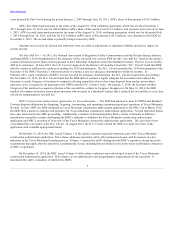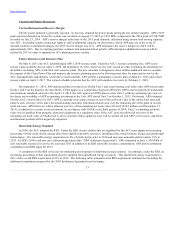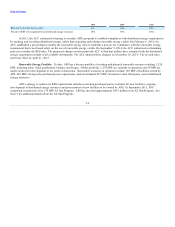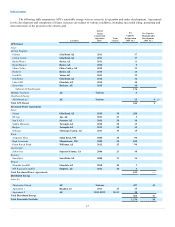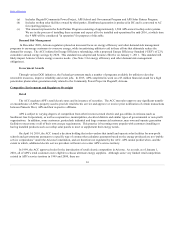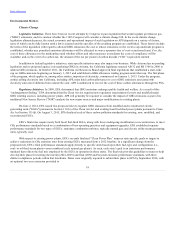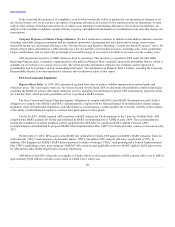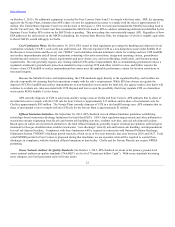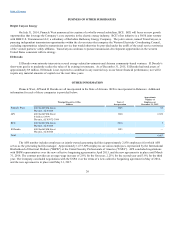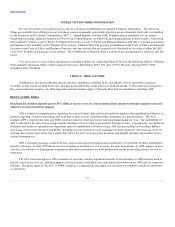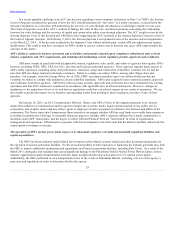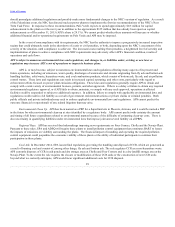APS 2015 Annual Report Download - page 22
Download and view the complete annual report
Please find page 22 of the 2015 APS annual report below. You can navigate through the pages in the report by either clicking on the pages listed below, or by using the keyword search tool below to find specific information within the annual report.
Table of Contents
states establishing a need for additional time; however, it is expected that this timing will be impacted by the court-imposed stay
described below.
ADEQ, with input from a technical working group comprised of Arizona utilities and other stakeholders, is presently working to
develop a compliance plan for submittal to EPA. In addition to these on-going state proceedings, EPA has taken public comments on
proposed model rules and a proposed federal compliance plan, which included consideration as to how the Clean Power Plan will apply
to EGUs on tribal land such as the Navajo Nation.
The legality of the Clean Power Plan is being challenged in the U.S. Court of Appeals for the D.C. Circuit; the parties raising this
challenge include, among others, the ACC. On February 9, 2016, the U.S. Supreme Court granted a stay of the Clean Power Plan
pending judicial review of the rule, which temporarily delays compliance obligations under the Clean Power Plan. We cannot predict
the extent of such delay.
With respect to our Arizona generating units, we are currently evaluating the range of compliance options available to ADEQ,
including whether Arizona deploys a rate- or mass-based compliance plan. Based on the fuel-mix and location of our Arizona EGUs,
and the significant investments we have made in renewable generation and demand-side energy efficiency, if ADEQ selects a rate-
based compliance plan, we believe that we will be able to comply with the Clean Power Plan for our Arizona generating units in a
manner that will not have material financial or operational impacts to the Company. On the other hand, if ADEQ selects a mass-based
approach to compliance with the Clean Power Plan, our annual cost of compliance could be material. These costs could include costs to
acquire mass-based compliance allowances.
As to our facilities on the Navajo Nation, EPA has yet to determine whether or to what extent EGUs on the Navajo Nation will
be required to comply with the Clean Power Plan. EPA has proposed to determine that it is necessary or appropriate to impose a federal
plan on the Navajo Nation for compliance with the Clean Power Plan. In response, we filed comments with EPA advocating that such a
federal plan is neither necessary nor appropriate to protect air quality on the Navajo Nation. If EPA reaches a determination that is
consistent with our preferred approach for the Navajo Nation, we believe the Clean Power Plan will not have material financial or
operational impacts on our operations within the Navajo Nation.
Alternatively, if EPA determines that a federal plan is necessary or appropriate for the Navajo Nation, and depending on our
need for future operations at our EGUs located there, we may be unable to comply with the federal plan unless we acquire mass-based
allowances or emission rate credits within established carbon trading markets, or curtail our operations. Subject to the uncertainties set
forth below, and assuming that EPA establishes a federal plan for the Navajo Nation that requires carbon allowances or credits to be
surrendered for plan compliance, it is possible we will be required to purchase some quantity of credits or allowances, the cost of which
could be material.
Because ADEQ has not issued its plan for Arizona, and because we do not know whether EPA will decide to impose a plan or,
if so, what that plan will require, there are a number of uncertainties associated with our potential cost exposure. These uncertainties
include: whether judicial review will result in the Clean Power Plan being vacated in whole or in part or, if not, the extent of any
resulting compliance deadline delays; whether any plan will be imposed for EGUs on the Navajo Nation; the future existence and
liquidity of allowance or credit compliance trading markets; the applicability of existing contractual obligations with current and former
owners of our participant-owned coal-fired EGUs; the type of federal or state compliance plan (either rate- or mass-based); whether or
not the trading of allowances or credits will be authorized mechanisms for compliance with any final EPA or ADEQ plan; and how units
that have been closed will be treated for allowance or credit allocation purposes.
19


